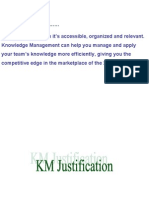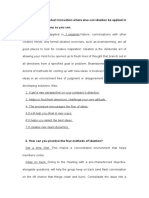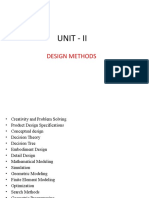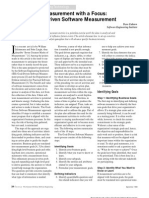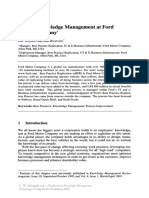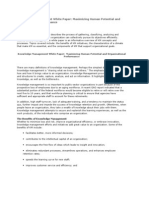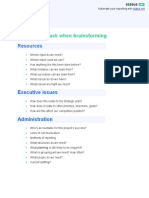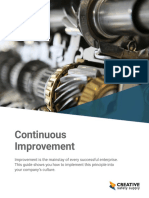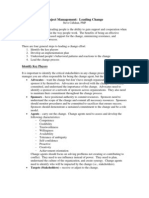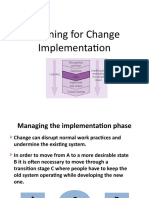AN EFFECTIVE CHANGE MANAGEMENT
PROCESS
- Ahmad Sheparuddin
Executive Director
HR & Admin
PHP Group.
So far we have seen that change is much more about people than process, and lasting
change has a lot to do with good leadership and people management skills.
So what does an effective change management process look like, and how is it
implemented? The following 6 step framework is a good basis to start from for any
organisational change programme, regardless of size or impact.
The starting point is the recognition that a change programme has to be defined well
enough and have outcomes clear enough and valuable enough to make it worthwhile
doing at all. (This may seem intuitively obvious, but its one of the main reasons why so
many change programmes fail to achieve their epected targets!.
"n effect we have to answer # $uestions that underpin the change process%
&! 'here are we now?
(! 'here do we want to be?
#! )ow are we going to get there?
*nswering these $uestions will provide the basic scope + a short document that lays out
the case for change, the benefits to be gained and a basic risk assessment that
addresses the ma,or unknowns.
This then provides the starting point for the pro,ect management process that is needed
as an -umbrella. or overarching process inside which the change process fits. (This
guide does not go into the details of the pro,ect management process, other than where
it overlaps directly with the change process. "t is assumed that such a multi/stage
process for managing pro,ects is available for use!.
&
Secondly, an assessment of stakeholder perception is necessary. This process simply
defines all the stakeholders in the change process, and establishes what their -position.
is with regard to the potential change. This covers how they see it, how they might
react, and any alternative positions they may hold. 0inally it addresses how positive or
otherwise they may be to the overall change agenda.
* degree of data collection through focus groups and informal meetings is likely to be
needed to establish the true stakeholder positions.
Stakeholder analysis is essential at the start of any change. "t helps establish the impact
and degree of acceptance to it + and this is critical if we are to know how hard we have
to work to make the change happen. There is no point in designing a huge change
programme for a change that everyone accepts and is more than happy to do anyway1
The 6/step process for effective change
&! 2stablish a clear direction + a compelling case and a sense of urgency
(! 3lear ownership and leadership
#! 3ommunicate the case for change early and often
4! 3reate and maintain a workable change plan
5! 2mpower broad/based action / maintain and measure progress
6! *nchor new approaches
Step 1: Estabish a cear direction ! a compein" case and a sense o# ur"enc$
0or any change, no matter how small, it is essential to have a clear and well thought out
understanding as to why change is necessary.
0or some leading edge organisations this can be less of an issue, because they put so
much effort into establishing and maintaining a culture of continual change + in effect for
them -change. becomes part of the leicon of everyday work.
)owever for most organisations this is not the case. 0or them the starting point is about
creating%
* clear case for change, approved at the appropriate level
(
* compelling and reasonable argument, laid out in the form of a directional
paper or memo
*n understanding of the timescale involved, even if its not fully defined
*n understanding of the urgency for change, and the conse$uences of not
changing
The right climate for change + the ground work with stakeholders to create an
initial sense of involvement and engagement with the challenge
Step & cannot be rushed. "t is fundamental to effective change, and the dialogue with
key stakeholders is critical to shaping a comprehensive and viable approach. 6ften this
step takes place over several weeks or months, and is highly iterative + homing in on
the most appropriate approach and ultimately to the compelling case for change.
6ne of the biggest issues to be addressed in step & is how to create enough urgency
without overly stressing people + in effect ensuring it is taken seriously but at the same
time making sure the outline implementation timeframe is reasonable.
7eople have a natural tendency to relegate things they perceive as unnecessary to the
bottom of their -to do. list. "f this occurs with the key people who are essential for early
engagement and buy/in, then nothing will happen. So creating the collective sense of
urgency and priority with key stakeholders is critical to getting a good start at all.
"n some cases, particularly where change is necessary as a prere$uisite for effective
business continuation, then senior leaders will often have to declare the situation as
urgent and high priority with limited discussion and feedback, in order to ensure early
action and progress.
Step %: &ear o'nership and eadership
The net step in the process is to ensure that there is clarity around who is leading the
process and who will approve the actions to be taken. 0or most ma,or changes there
will also be a leadership team, reporting to the pro,ect manager, that needs to be
briefed, fully engaged and have the capacity (i.e. time and priority! to contribute to the
process.
#
*s well as establishing the management (or governance! process, it is also essential to
establish the guiding principles and vision that all stakeholders involved in the change
process can buy into. This defines how the team will work together, how they will
communicate to other people, and how they will eplain the issues to others when
appropriate. "t is crucial that this is done with a common message and language. 7eople
will simply not follow the lead of a team that is perceived to be divided and acting as
anything other than good role models to them.
"t is also good practice at this stage to identify who the -champions of change. might be.
The reality is that it8s the champions, the people who will take a positive approach and
use the right constructive and visionary language, who make lasting change happen.
There is a critical mass element to this, and a basic -rule. of change is that there needs
to be enough change championing occurring appropriate to the magnitude of the
change, if such changes are going to be made in a reasonable timeframe. The reality is
that having fewer champions translates into a longer change transition period, and this
can have a ma,or impact on the ultimate effective change.
0inally it is critical that ownership for the change process is with the relevant line
managers. 3onsultants, )9 and other support teams can all help managers to develop
and implement successful change but line management ownership has to be clear from
start to finish. 3onse$uently there is often a strong case for identifying and appointing a
3hange 3oordinator : 0acilitator + someone who can work closely with the sponsor and
pro,ect leader to coordinate and facilitate day/to/day aspects of the change process.
This might for instance involve day/to/day pro,ect coordination and pro,ect team
facilitation. The role holder does not own the pro,ect, but does work to ensure effective
engagement of key stakeholders in getting to effective and timely solutions.
*t this stage it is also critical to establish how employees will be involved, and to what
degree + particularly those in leadership positions. The -9*3". approach can help here.
-9*3". stands for
Responsibility
Accountability
4
&onsult
(nform
*s we have seen above, establishing who is accountable is key + -where does the buck
stop.? There can be no confusion about this.
9esponsibility can be shared, but the accountable person needs to be clear about
')*T is being delegated to ')6;, and also to ensure that they have the necessary
authority and capability to act.
3onsult and "nform are critical. <asically you should aim and plan to consult with people
before decisions are made, and take feedback into account to some degree. )owever
there will also be times when all you need to do is to inform people, typically once a
decision has been made.
To what degree one needs to consult versus inform (or both! depends on the specific
circumstances of the change in $uestion. This is why it is so important to think this
through well before starting into a change process.
Step ): &ommunicate the case #or chan"e ear$ and o#ten
6ne of the biggest barriers to effective change is poor communication + or to be more
accurate poor perceived communication. *n effort may well have been made to
communicate, and the leadership team may well have felt they had done a good ,ob at
this, but its perception that counts. "f the message was poorly understood or
misunderstood, particularly where no effort has been made to clarify around concerns,
then resistance can be epected, and it might be serious1
"t is never too early to start the communication process. Section =! below contains a
comprehensive guide to effective communication during times of change.
Step *: &reate and maintain a 'or+abe chan"e pan
So far we have focused mainly on people issues, mainly because those are the ones
most likely to cause implementation challenges if not handled correctly.
5
)owever it is important to build and maintain a pro,ect plan for change that includes all
the normal pro,ect elements + ma,or tasks, deliverables, timeline, who does what, risk
assessment, logistical issues, etc. This will also include the more traditional elements of
change plans, such as%
Scope, i.e. what is included and what is not
6rganisational structure
9oles and responsibilities
Selection, recruitment and : or separation issues
"mplementation plans
7rogress review methodology
"t is important that the change process is recognised and planned as a pro,ect, and one
that includes all aspects of implementation as part of the pro,ect. (Typically for instance
this might include any necessary training and development + so often forgotten in
change programmes!.
*lthough a general pro,ect planning process might be used, it is important that the
pro,ect plan has the following key elements included%
"nitiate the pro,ect (including defining pro,ect board, team, manager!
>efine alternatives
Select alternative and plan for detailed implementation
2ecute the approved plan
6perate and make additional improvements
Step ,: Empo'er broad-based action ! maintain and measure pro"ress
6nce the decision has been made to make the change, then it is critical to -do
something. + in effect making it clear that there really will be a change and it will have
lasting benefit. =enerally speaking there is a -window of opportunity. to do this, because
6
if people see no changes and no action then they start to believe, wrongly, that the
change itself (and more worryingly the need for change! has gone away.
'hat is more, people can be keen and creative when involved in the change process,
particularly when it has a direct impact on helping shape the outcome. * mechanism
needs to be in place to allow for modification of the implementation plan, whilst still
monitoring the overall pro,ect scope and timeline.
Typical actions are%
* clear implementation plan with realistic timescales and milestones
3hanging structures and processes
2stablishing clear new reporting lines
0ocus on new team development and individual development needs
* culture of empowerment, trust and support
Setting up measurement processes + with clear targets
0ocus on dealing with problems and potential roadblocks
9ole modelling good leadership behaviours
Step -: Anchor ne' approaches
?o matter how effective the introduction of change may be, ultimately the -proof of the
pudding. will be how the new culture develops and embeds and how visible this process
is. "t is all about how effectively the transition is made from the current state to the
desired state + particularly embedding the behaviours necessary.
This will typically take the form of%
3ontinual reinforcement of the shared vision
2ncouraging and recognising reinforcing behaviours in others
9ecognising and taking with us -the best of the past.
@
6penly recognising people who do well
3elebrating as a team
2mbed a team approach with appropriate development and support
3lear linkages between individual ob,ectives and organisational success
9ealistic yet challenging goals and ob,ectives
* strong sense of - we will succeed or fail together.
"t is crucial to make an early effort to make the -new way the normal way.. "t is all too
easy to fall into the trap of continuing to work in the same ways as before, and to treat
the changes as something that will be done -when we have time.. This in effect makes
the change process a -bolt/on. rather than -core..
The language, behaviours and actions that leaders (at all levels! take will shape the
overall implementation and determine how effective it is. The key message is to
reinforce a -we. culture and avoid -they : them. language.
.r"anisationa Deveopment /..D0.
6rganisational >evelopment is a training programme to develop the 6rganisational
culture among the people in order to affect the change in a planned way. "t is an
intervention strategy that focuses on the whole culture of an 6rganisation to bring out
the planned change. "t seeks change of beliefs, attitudes, values, structure, and
practices to adapt the technology with the fast pace of change.
A




